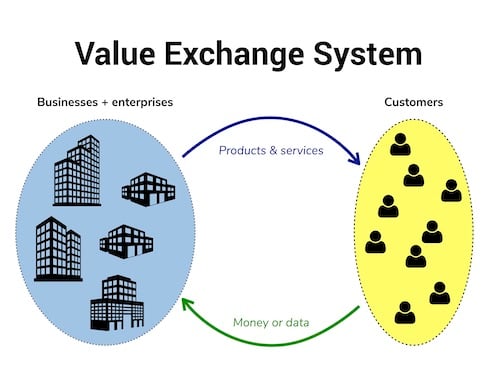
The second is defining the value exchange, how the consumer and the producer trade value in return for access to the product. For product managers and Product Owners, the first insights into what defines a value exchange is defined when product-market fit has been achieved. However, it is not until business model fit has been achieved that a scalable and profitable business model has been recognized. That means until business model fit has been identified, Product Owners and product managers are constantly optimizing their value exchange.
The diagram to the right provides an idealized version of how value exchange works. Businesses and enterprises produce products and services in response to what they perceive to be unmet needs in the market. Customers somehow find these products and use them. If the products provide value to the customer, an exchange is made. In most cases, the value exchange is money. However, with companies like Google and Facebook, the value exchange is often your personal data.
In reality, value exchange is a little more complicated than customers handing over money to producers. In the quest to find business model fit, product managers and Product Owners have a variety of options at their disposal which will allow them to design a value exchange that is win-win for both the consumer and the producer. Here are the seven most common value exchange models for software products and services.
- Time-based access: grants “rights to use” for a defined period of time, e.g. perpetual, annual, rental, subscription, pay after use, etc.
- Transaction: defined and measurable units of work tied to a transaction. In this case, customer value, and therefore the price, is often associated with an attribute of the transaction, e.g. duration, time of day of the call, etc.
- Meter: counting a constrained, well-define, identifiable resource, e.g. concurrent usage of resources, number of active users, an absolute value (100 hours or some other amount), etc.
- Hardware: value of the software is associated with the hardware the customer purchases, e.g. microwave ovens, routers, VPN servers, consumer electronics, automobiles, etc. This presents the producer with the challenge of the software becoming “free” from the perspective of the customer.
- Service: value exchange tied to a service offered by the producer. In this case, the software purchased by the customer is required to provide the service or is intimately related to the service, e.g. anti-virus software, Google Suite, Red Hat Linux services, like support or upgrade, etc. This value exchange is often associated with subscription pricing.
- Revenue obtained (or cost saved): value is based most commonly on percentage of revenue obtained or costs saved.
- Content: software creates or contains unique data or content. Value exchange provides access to the content, e.g. FICO scores, Getty Images, etc.




